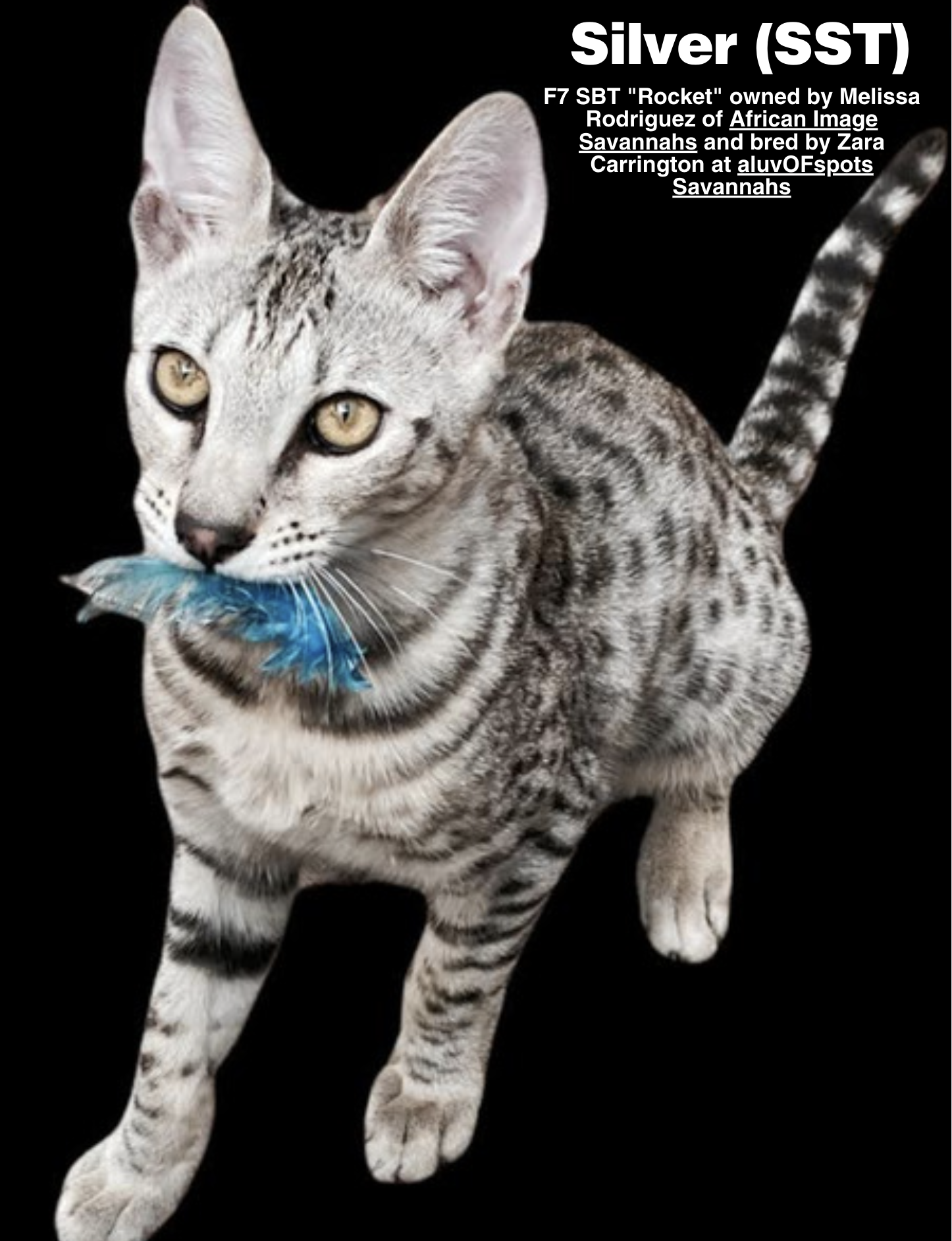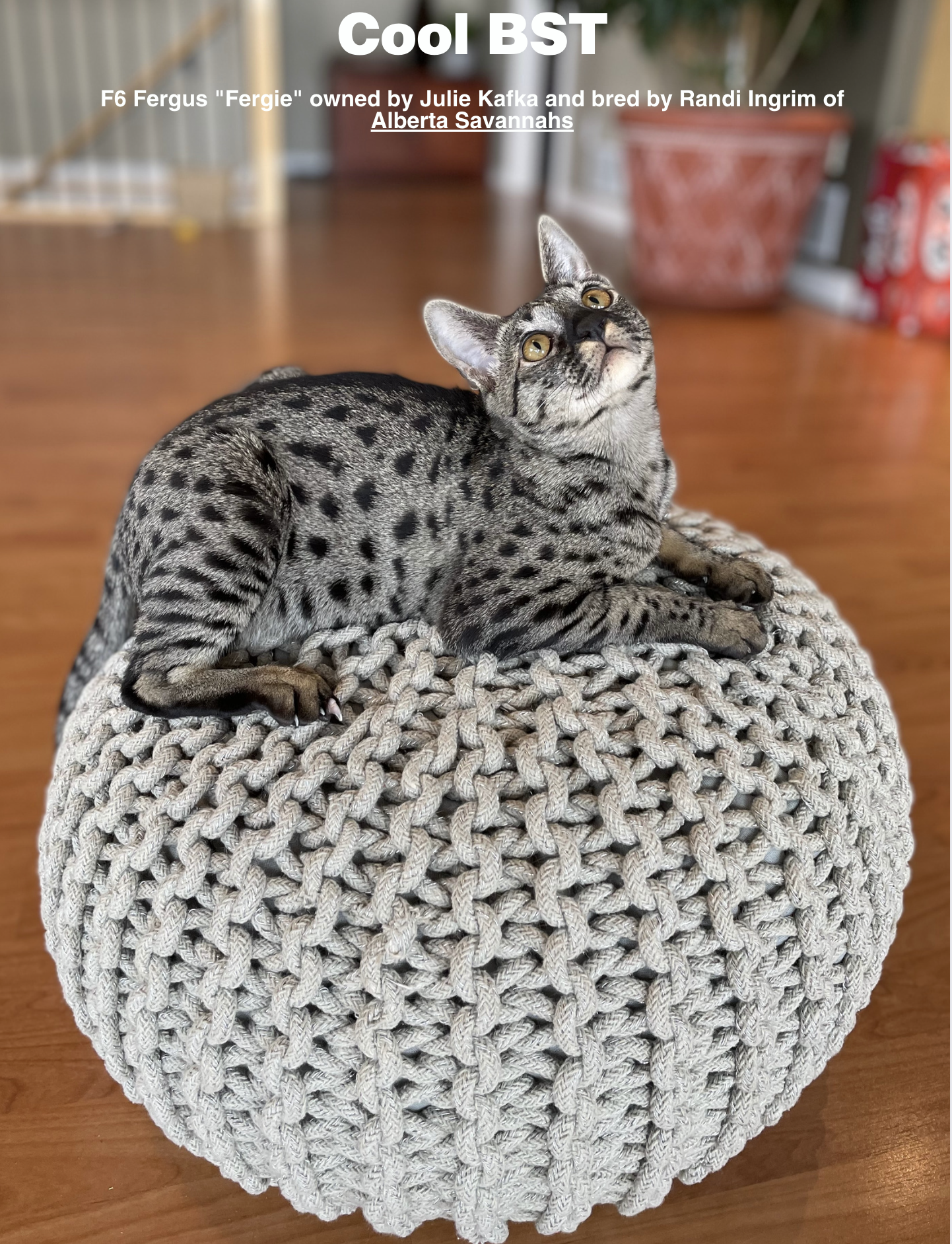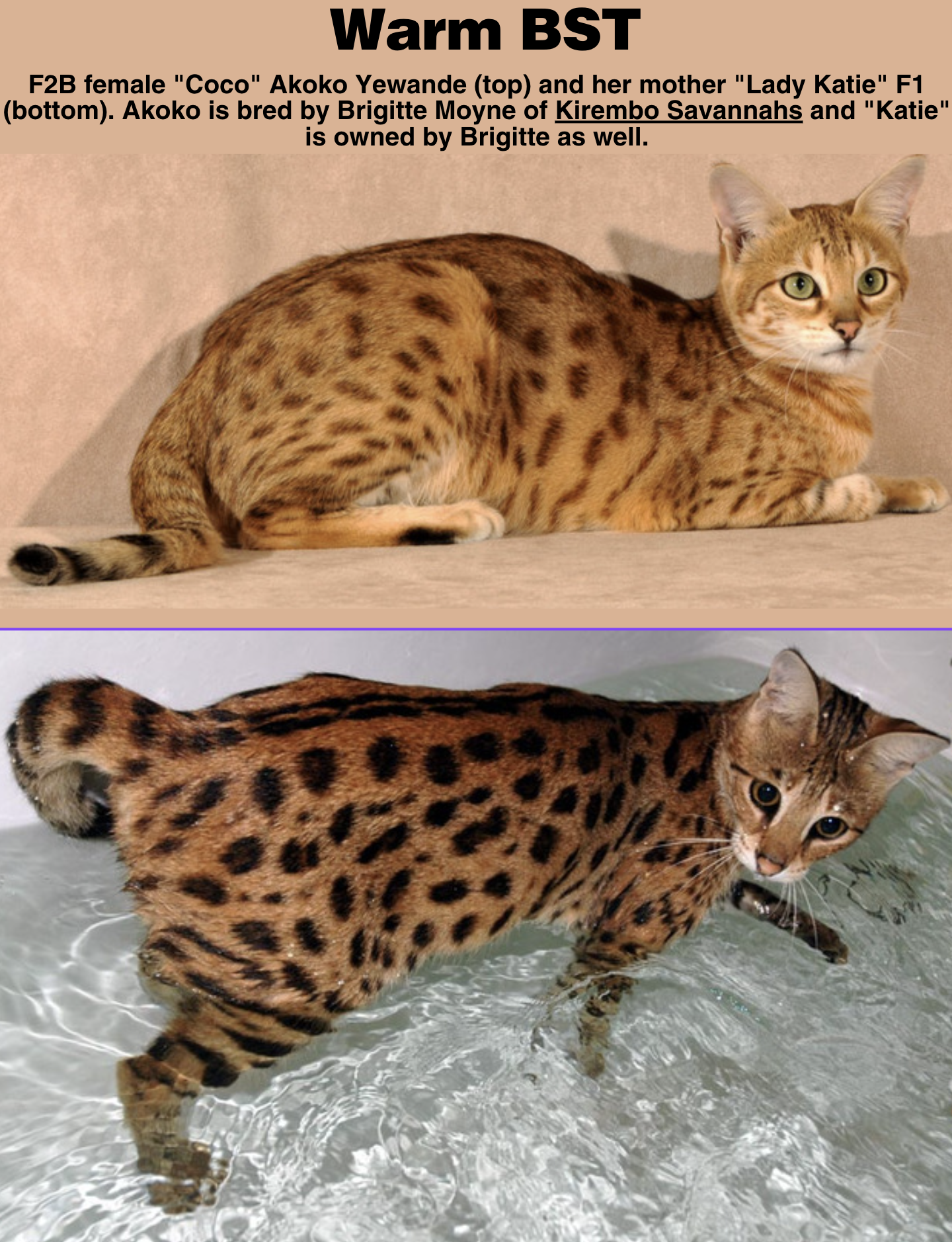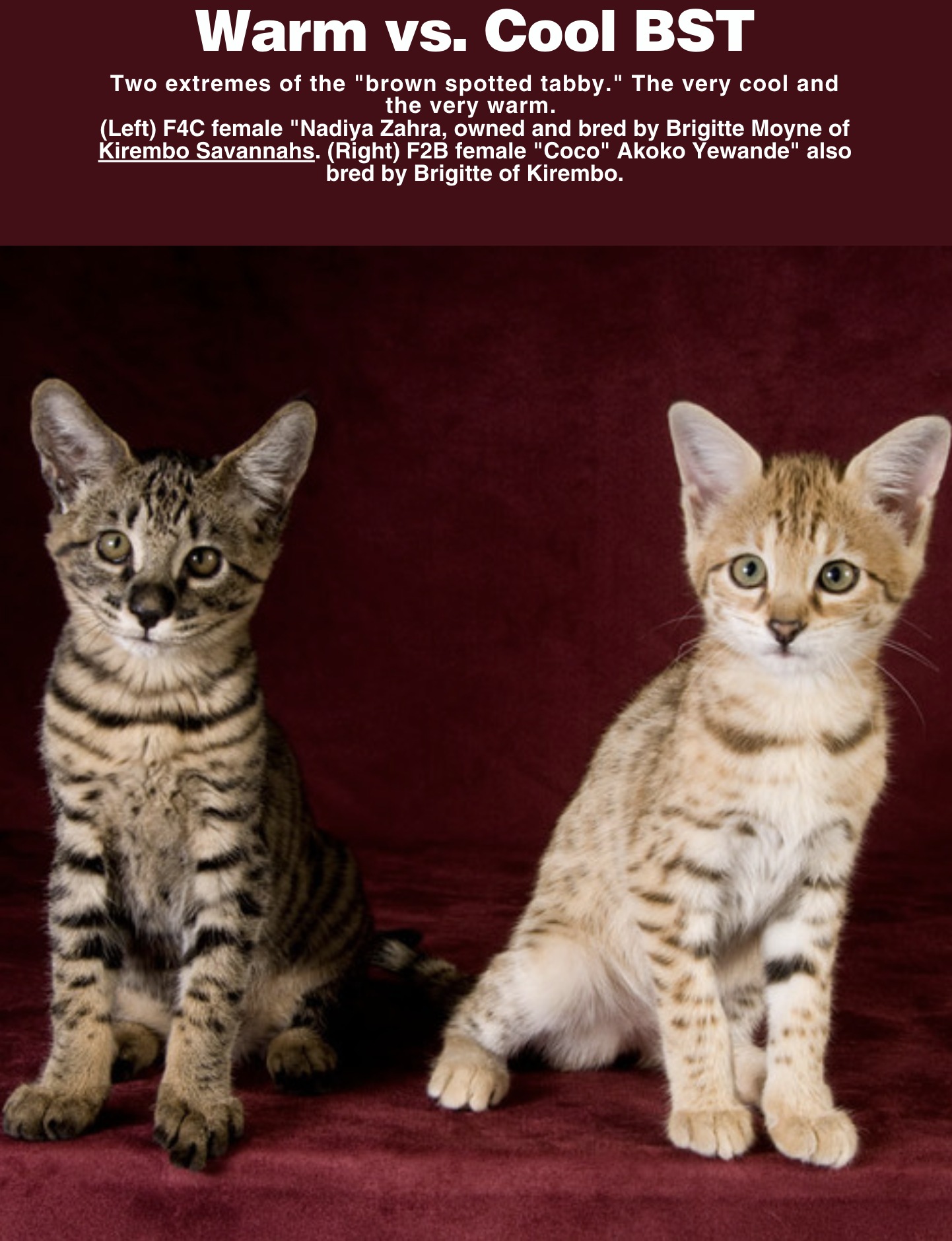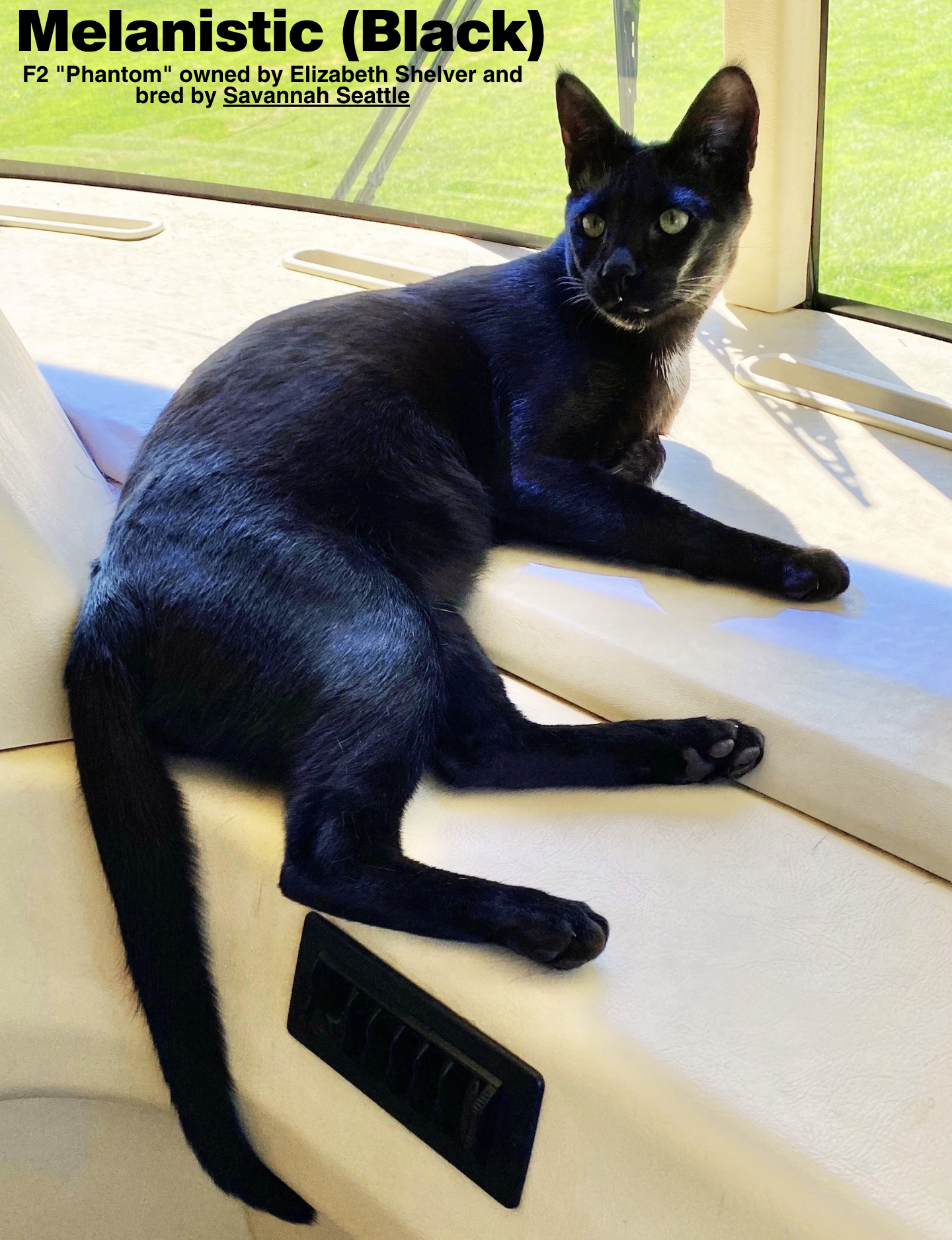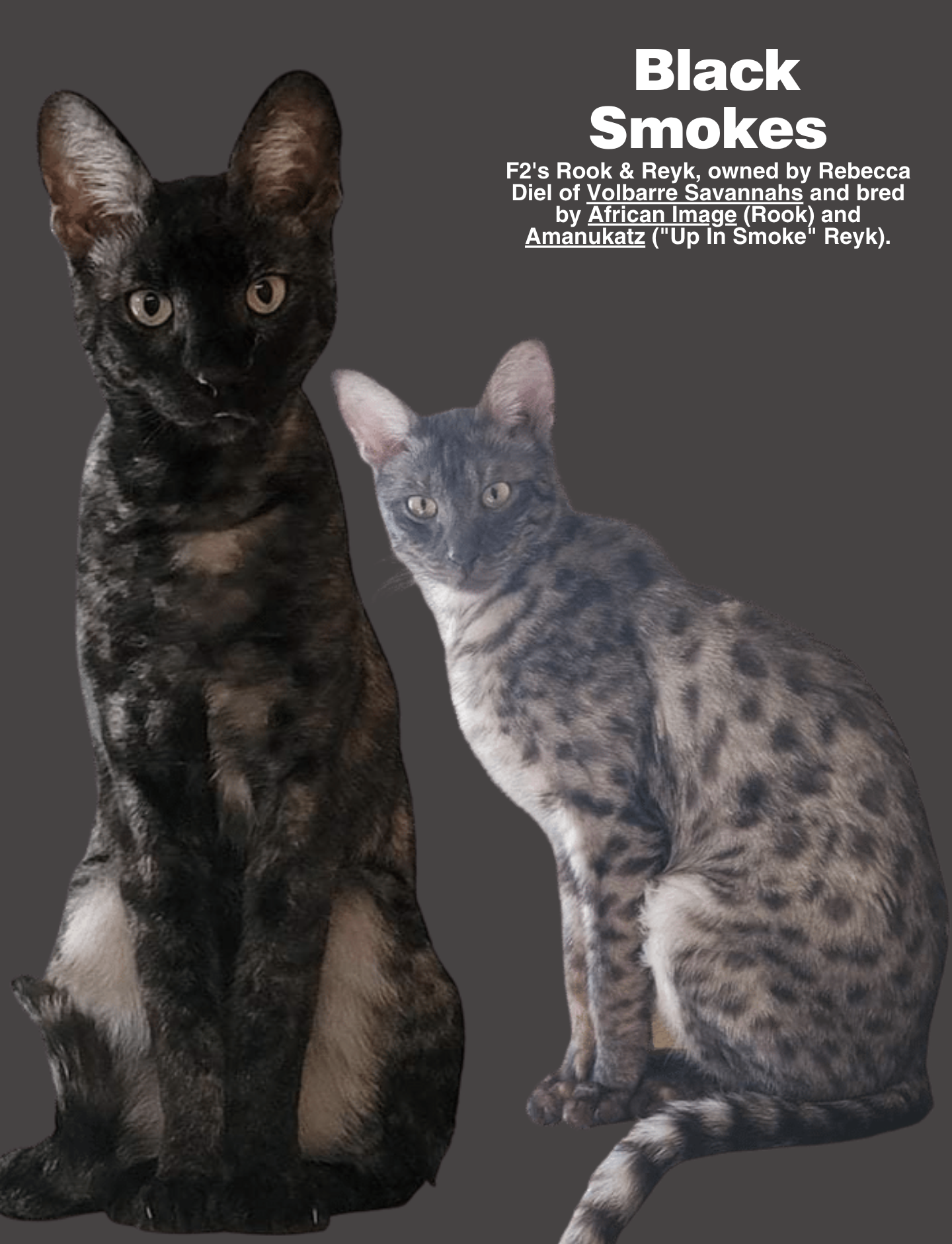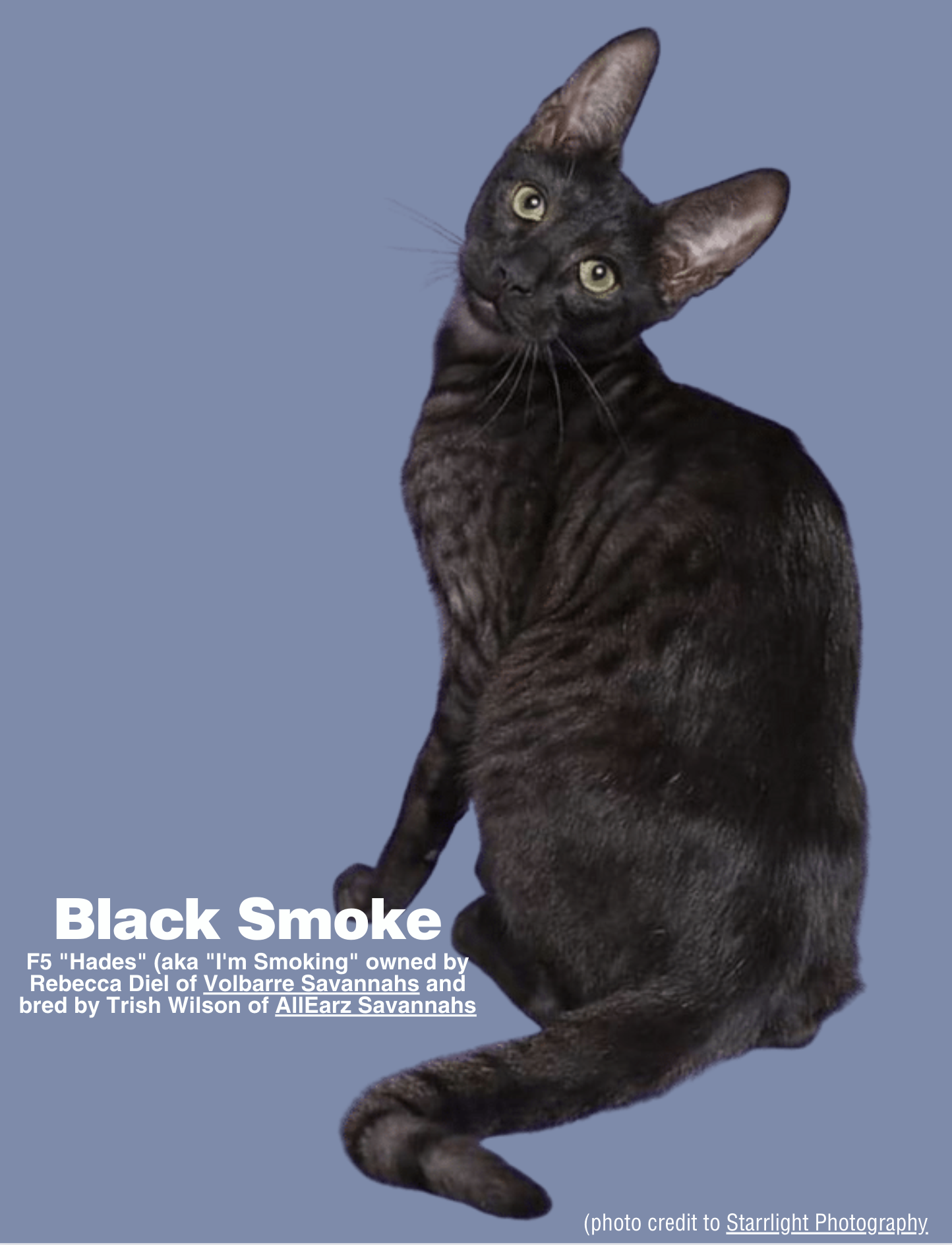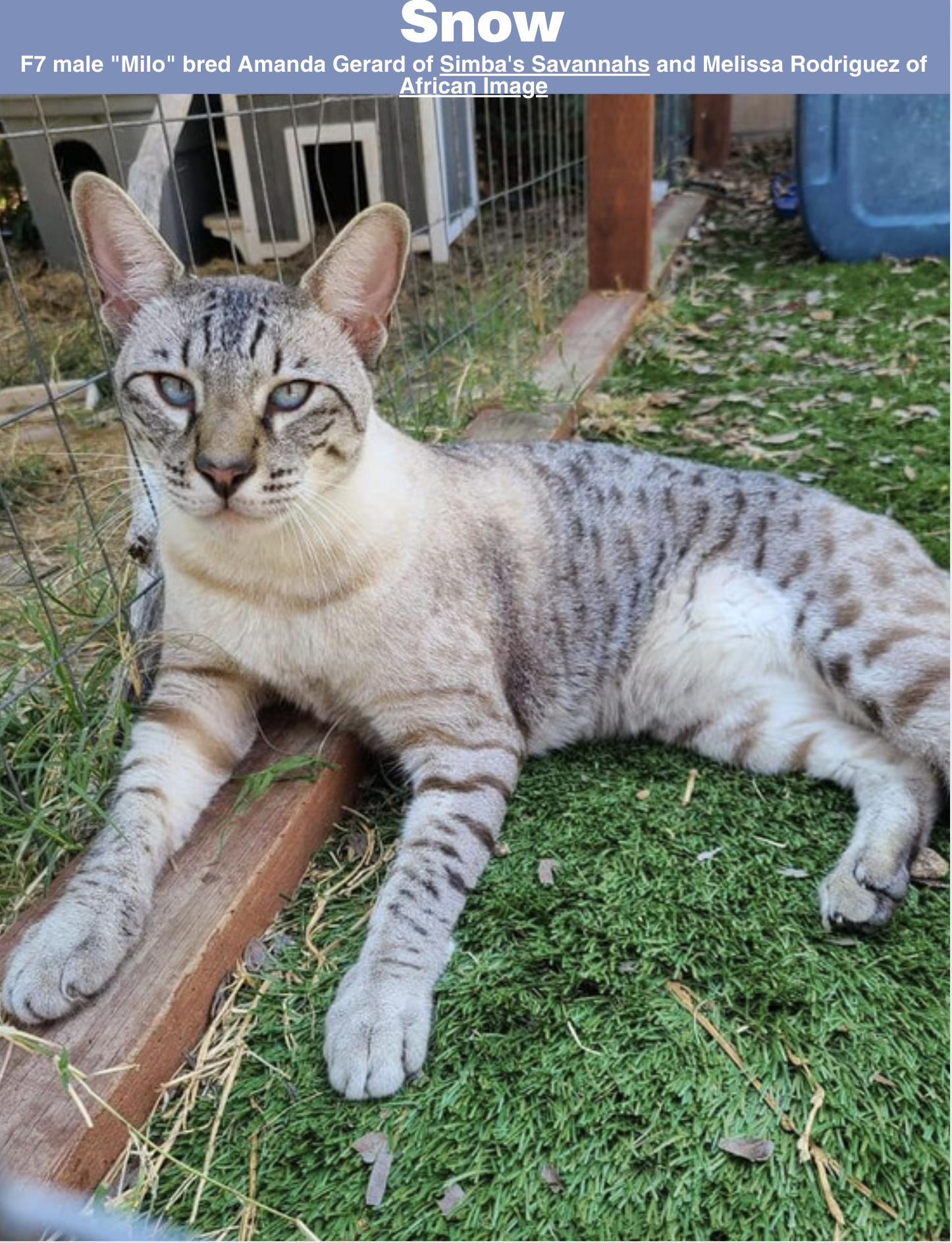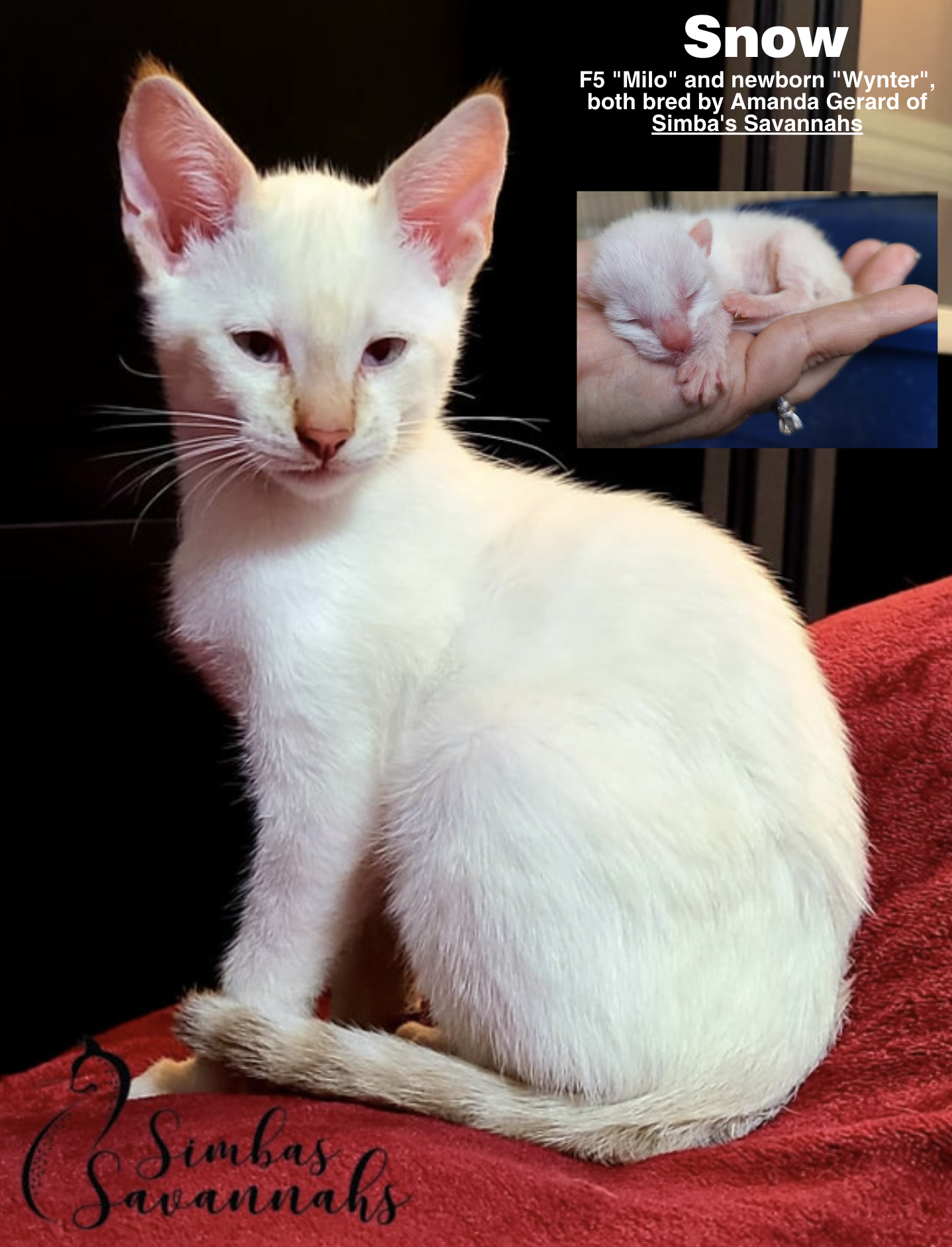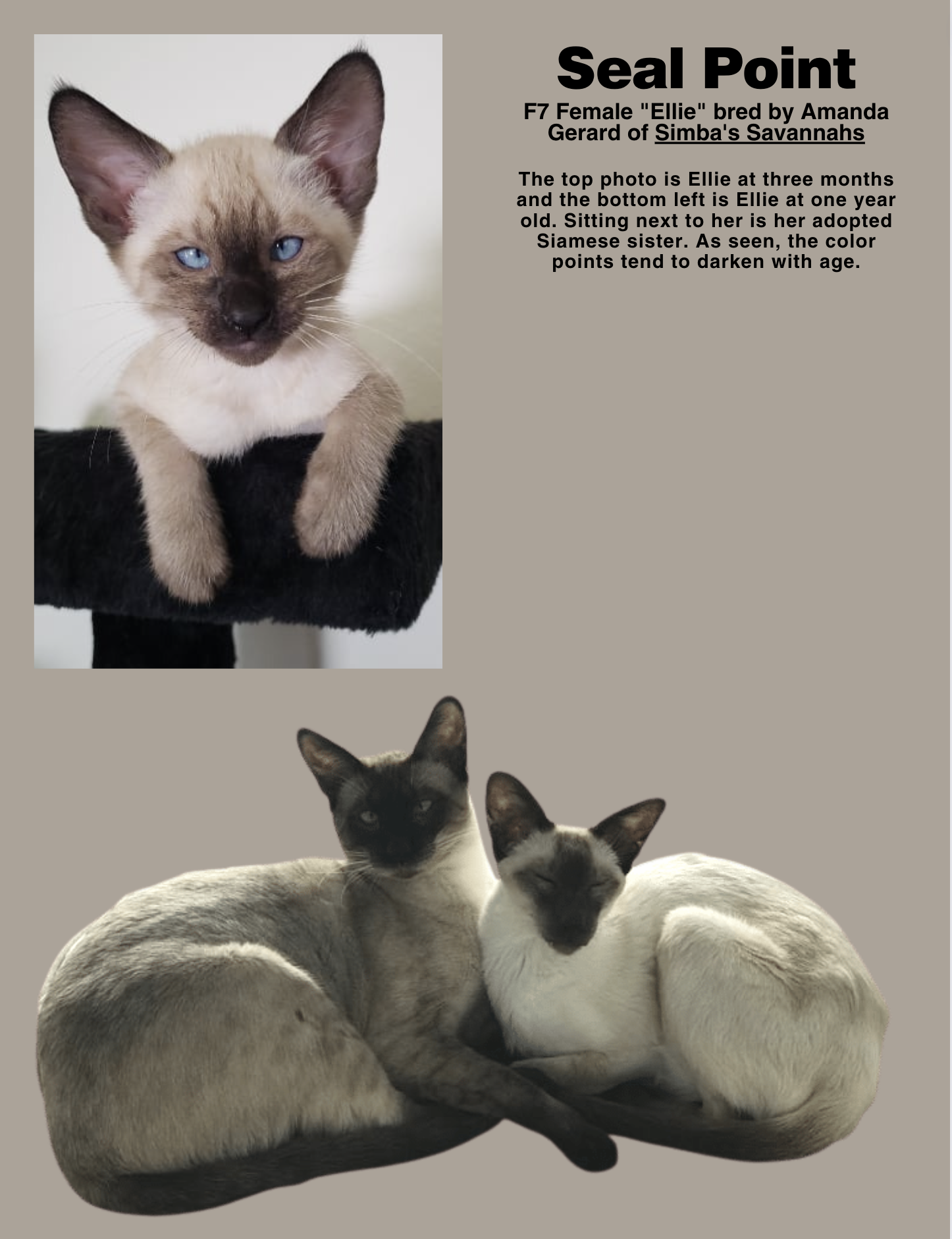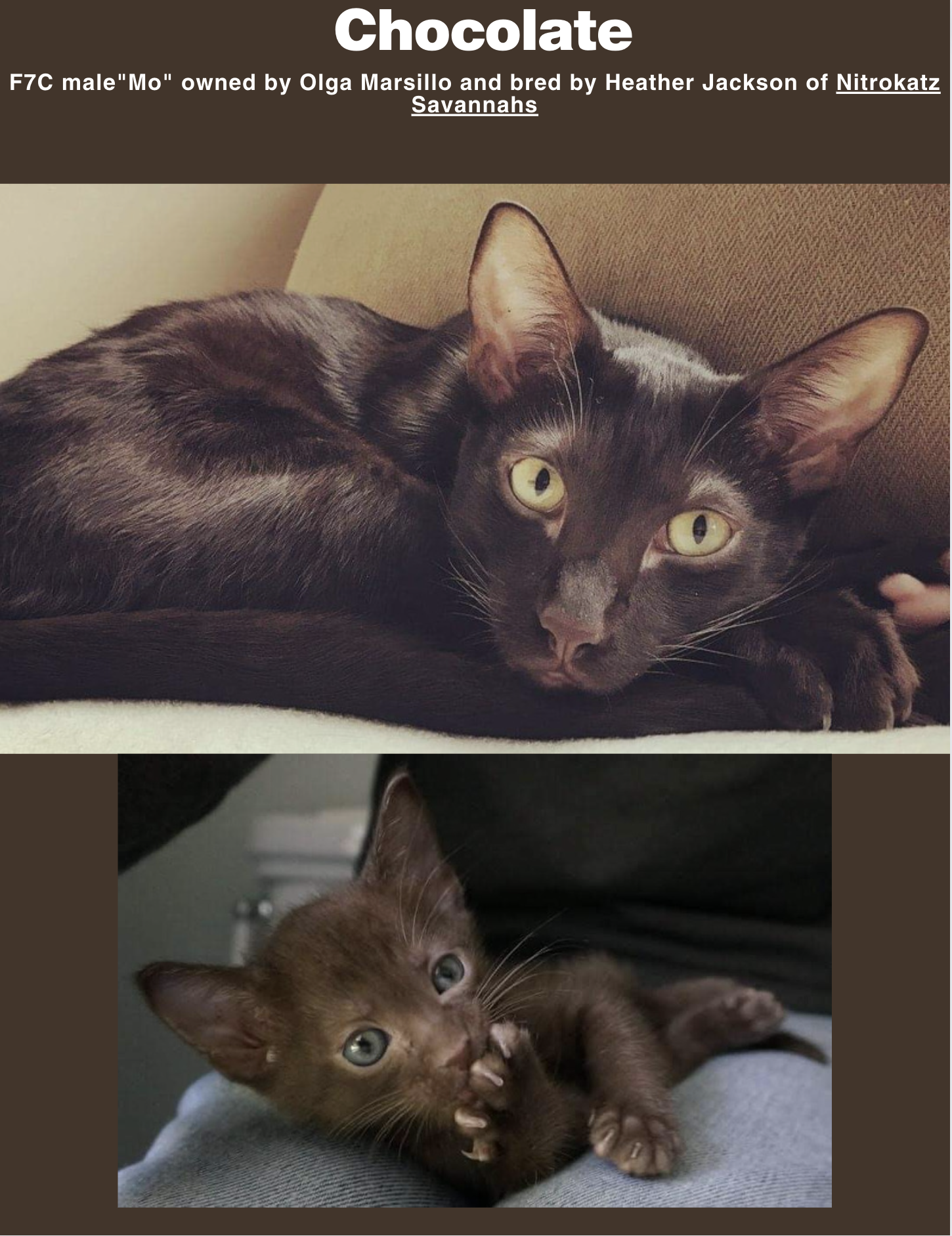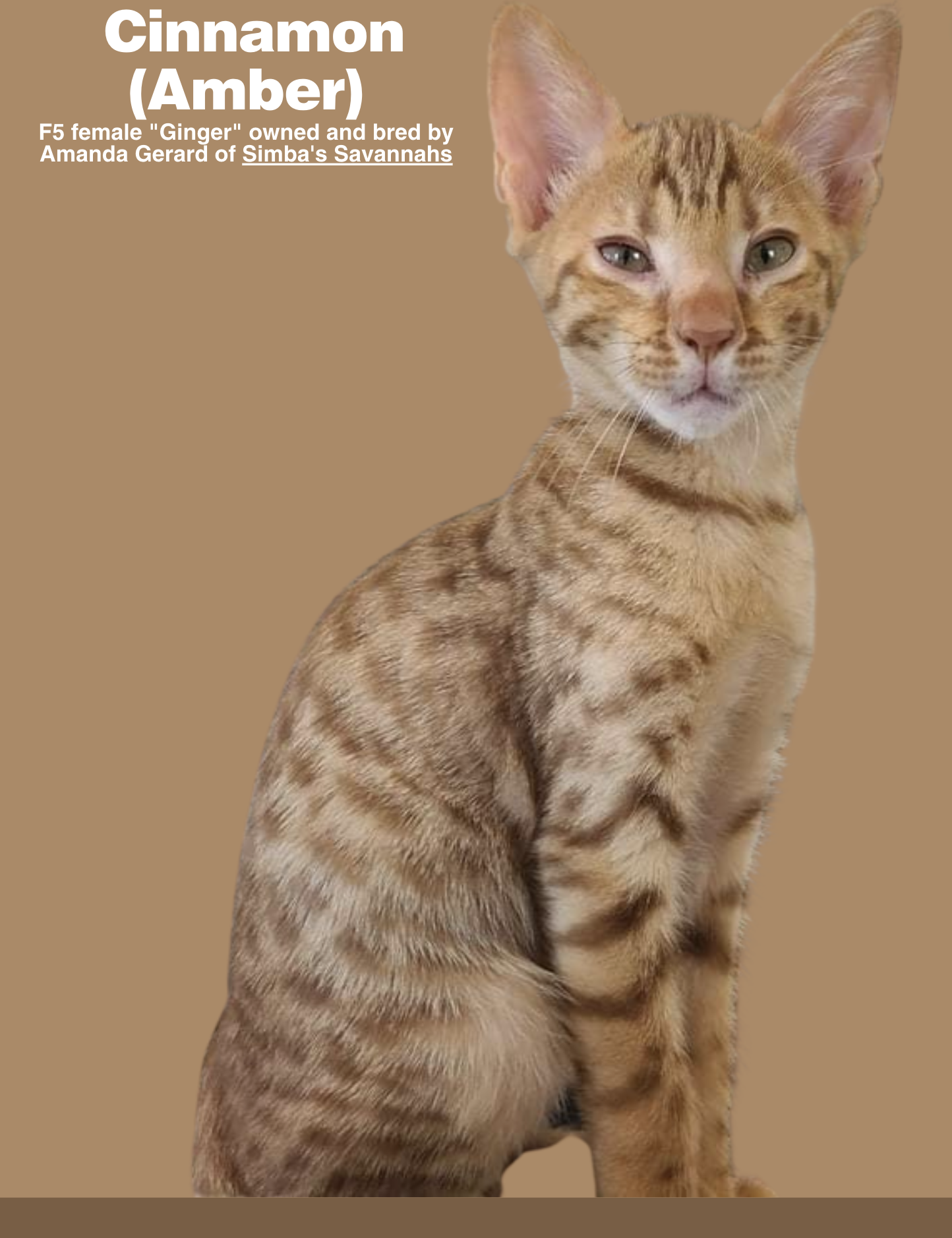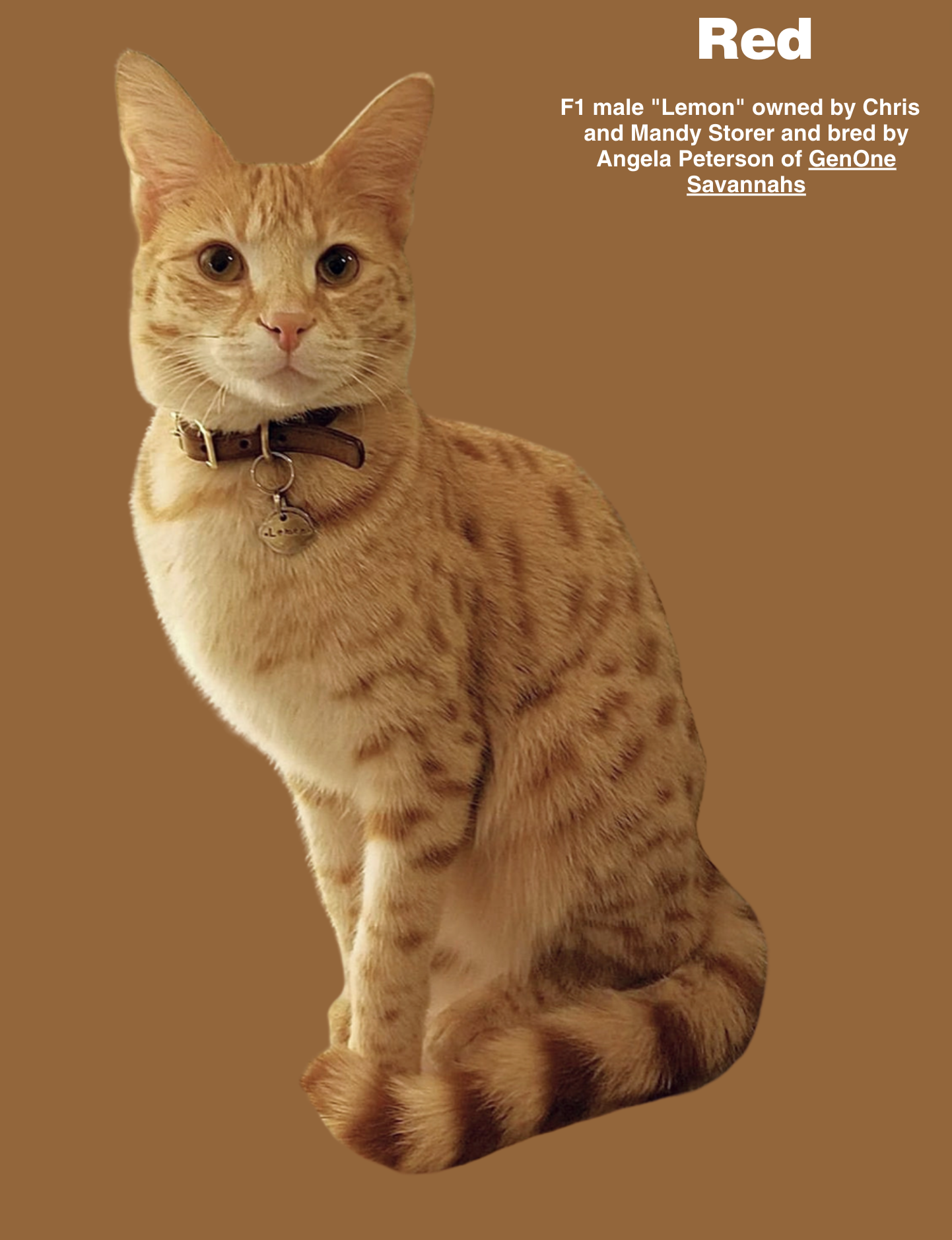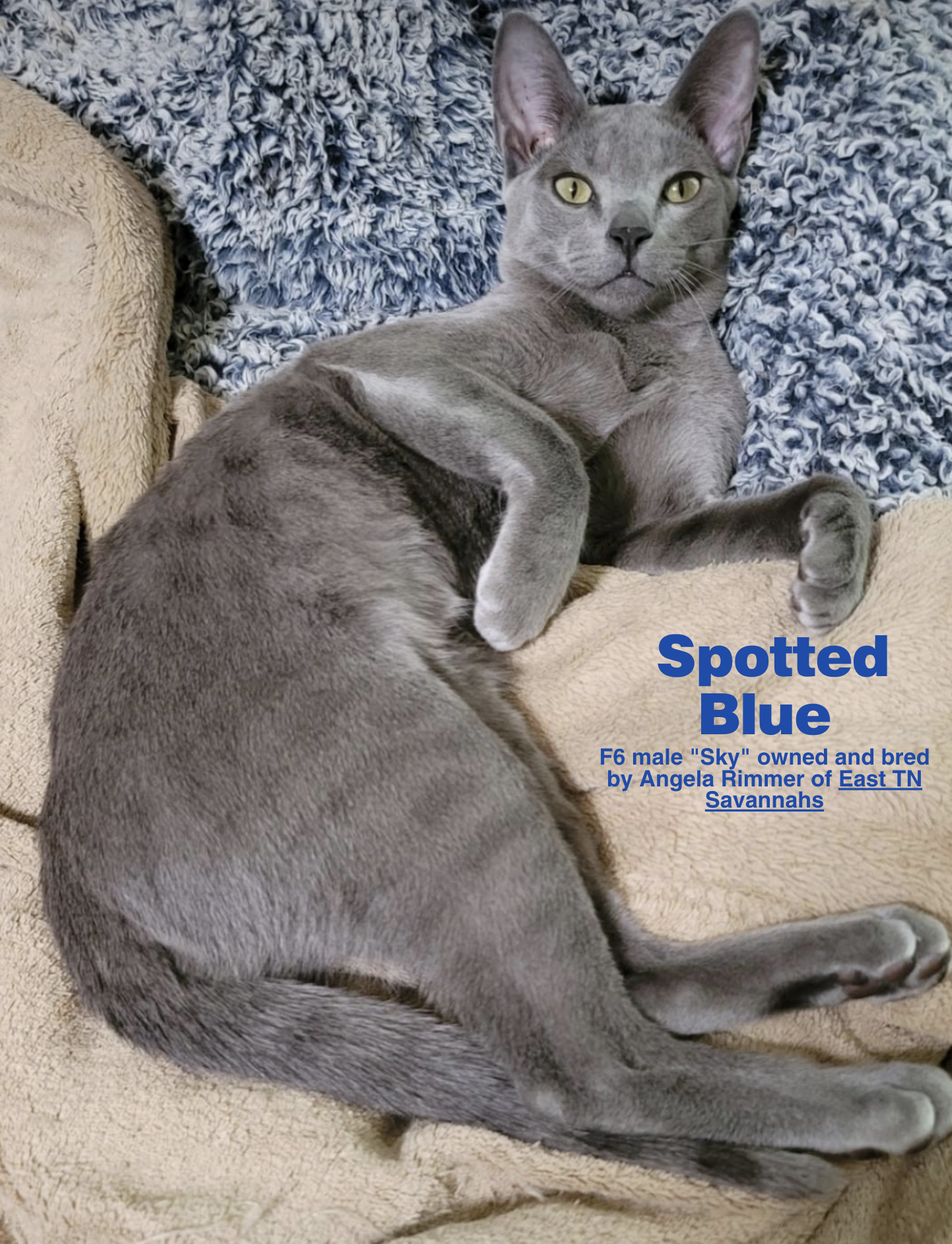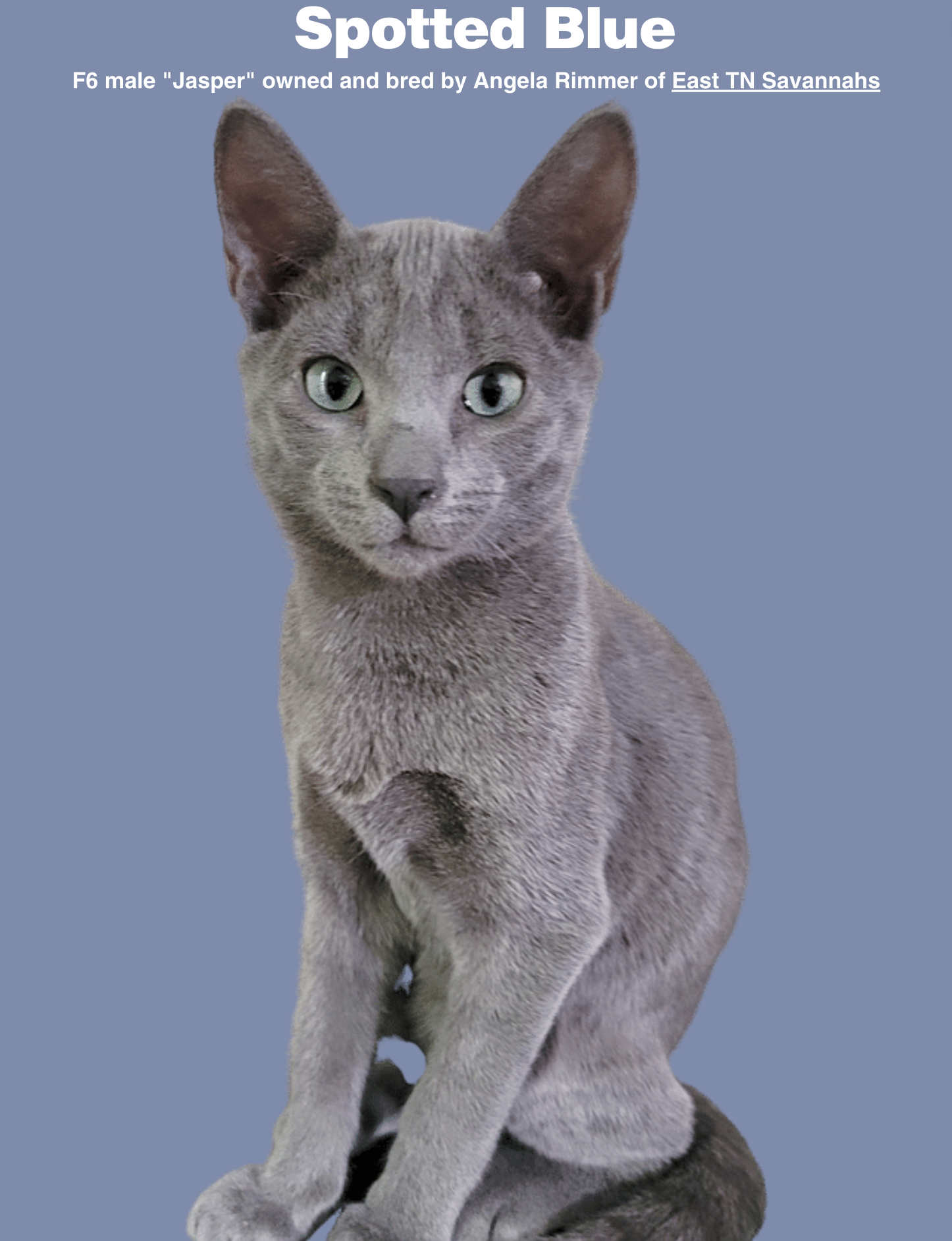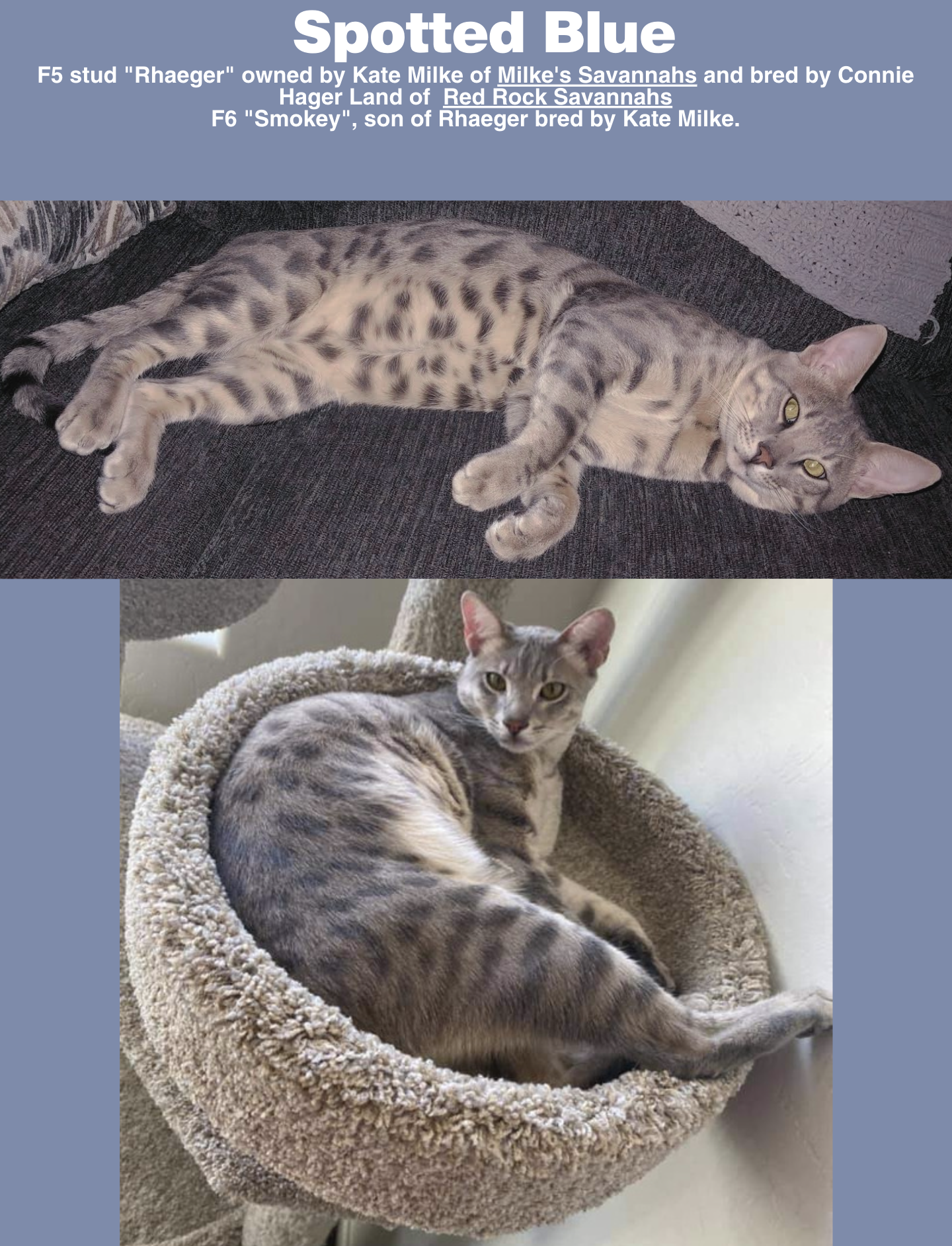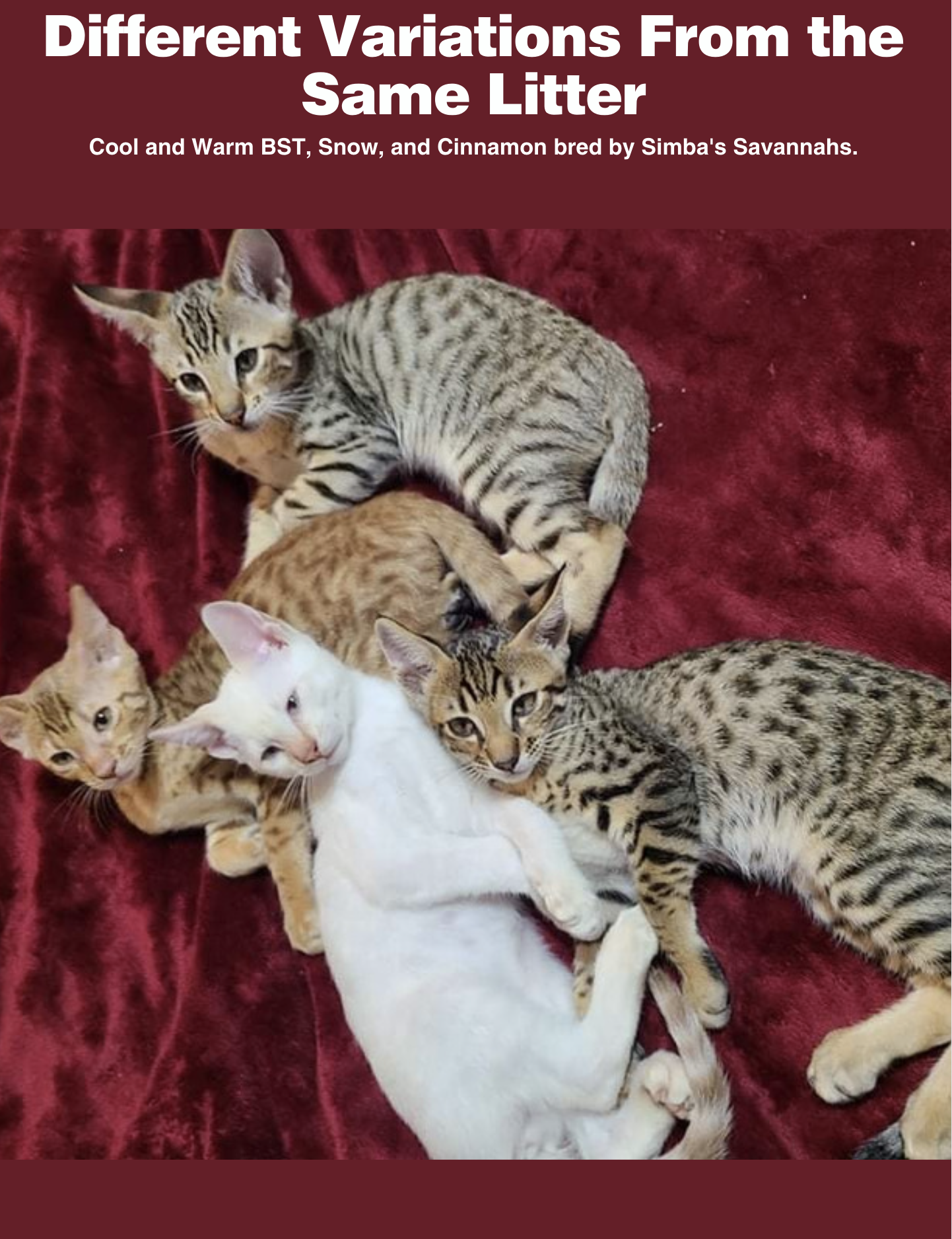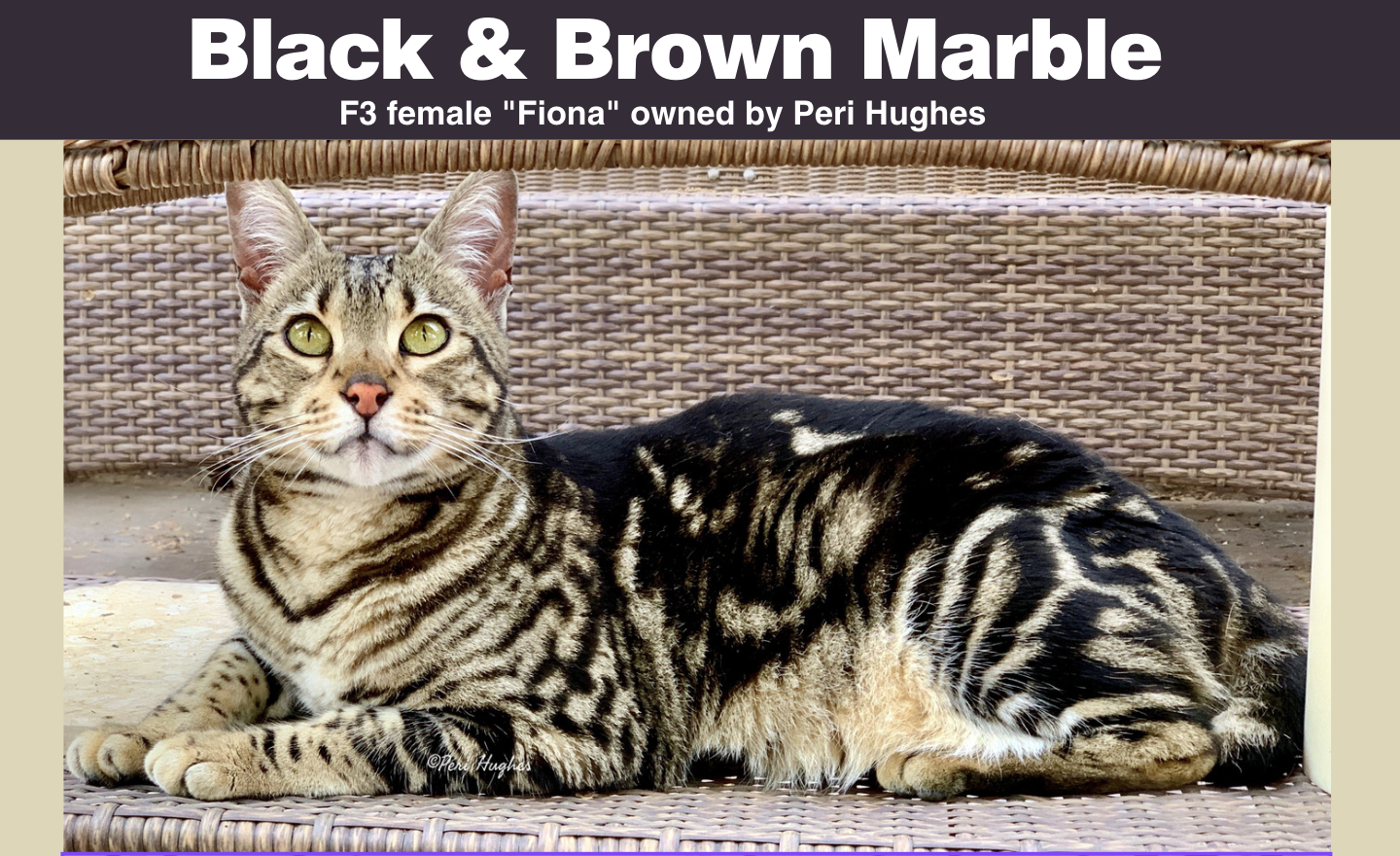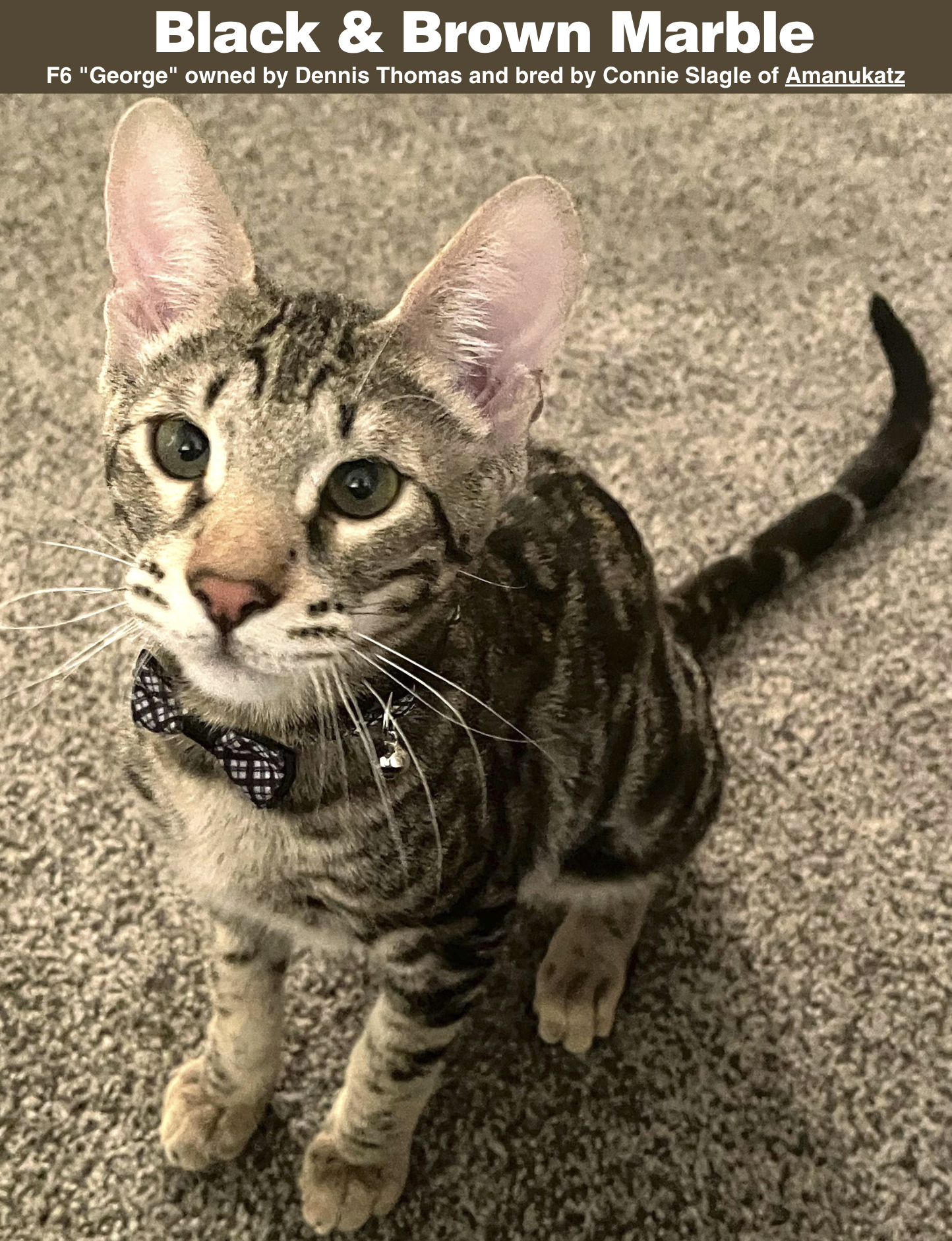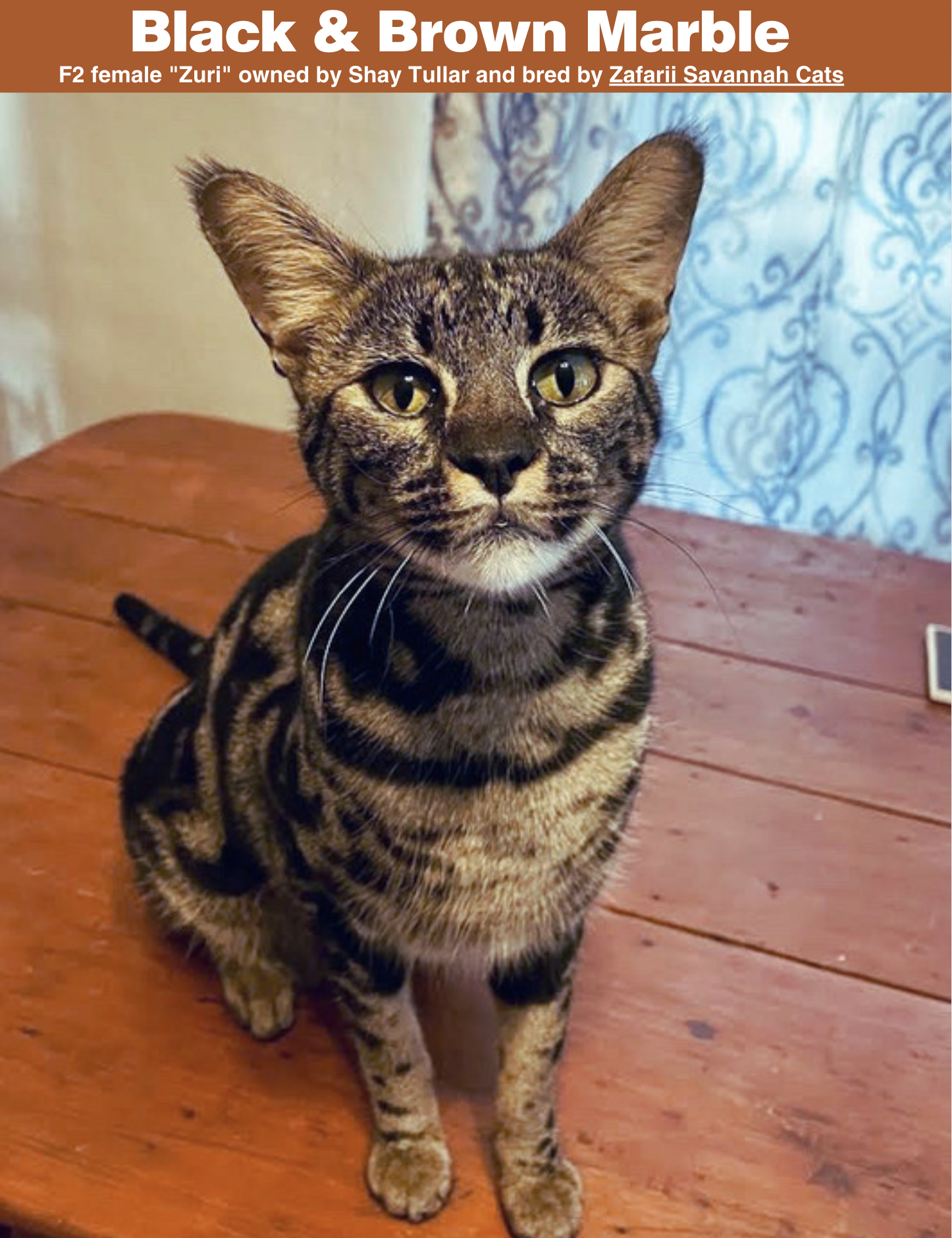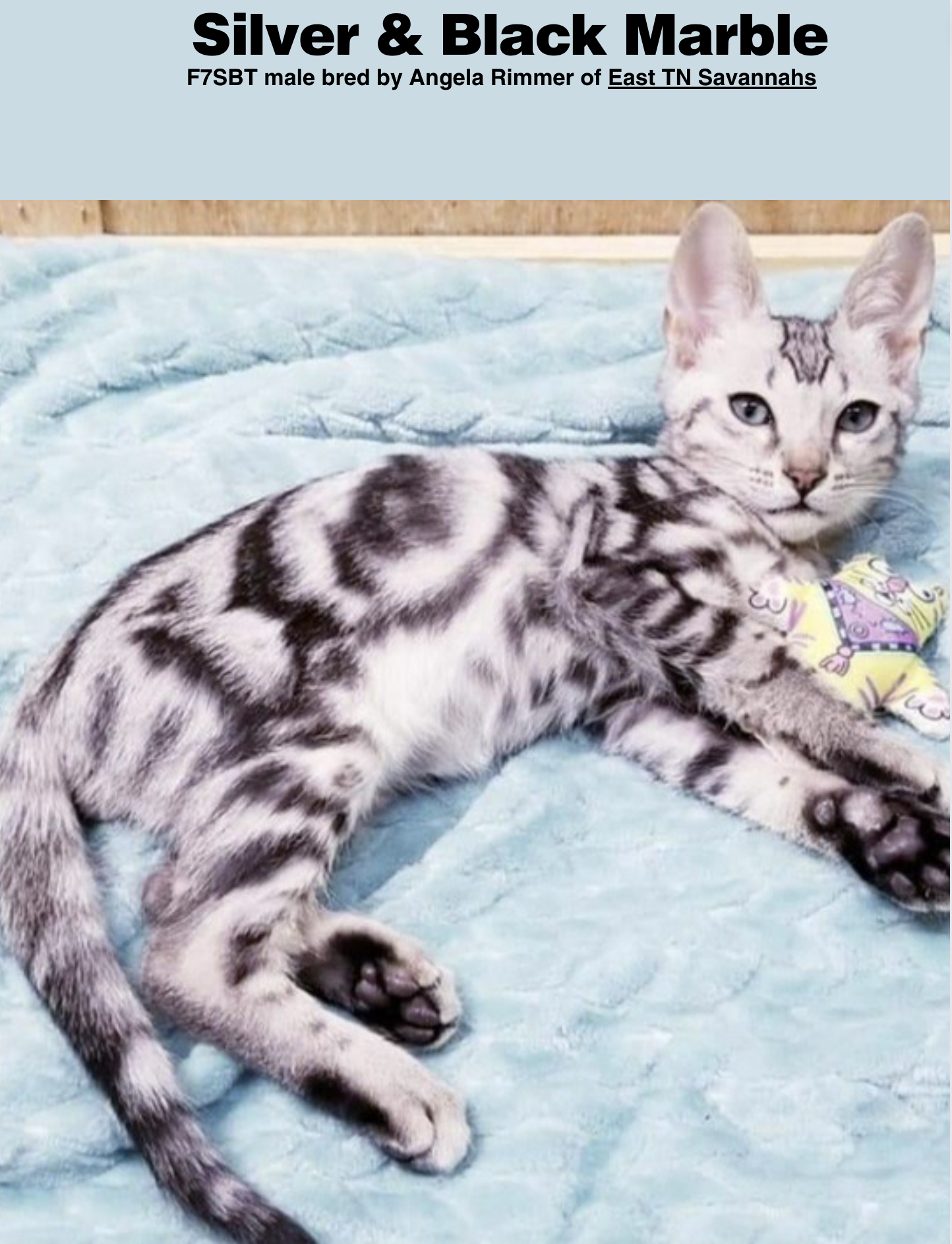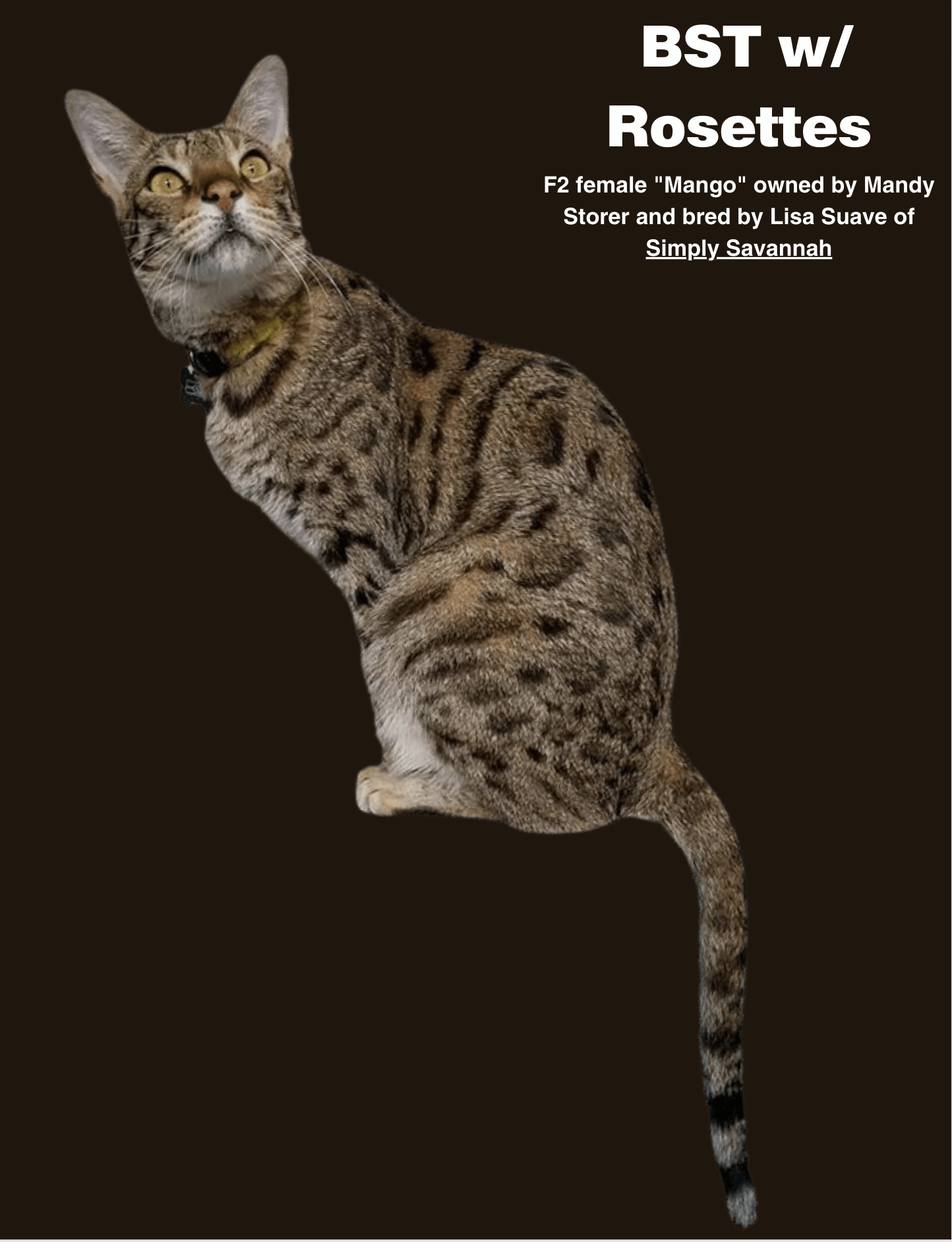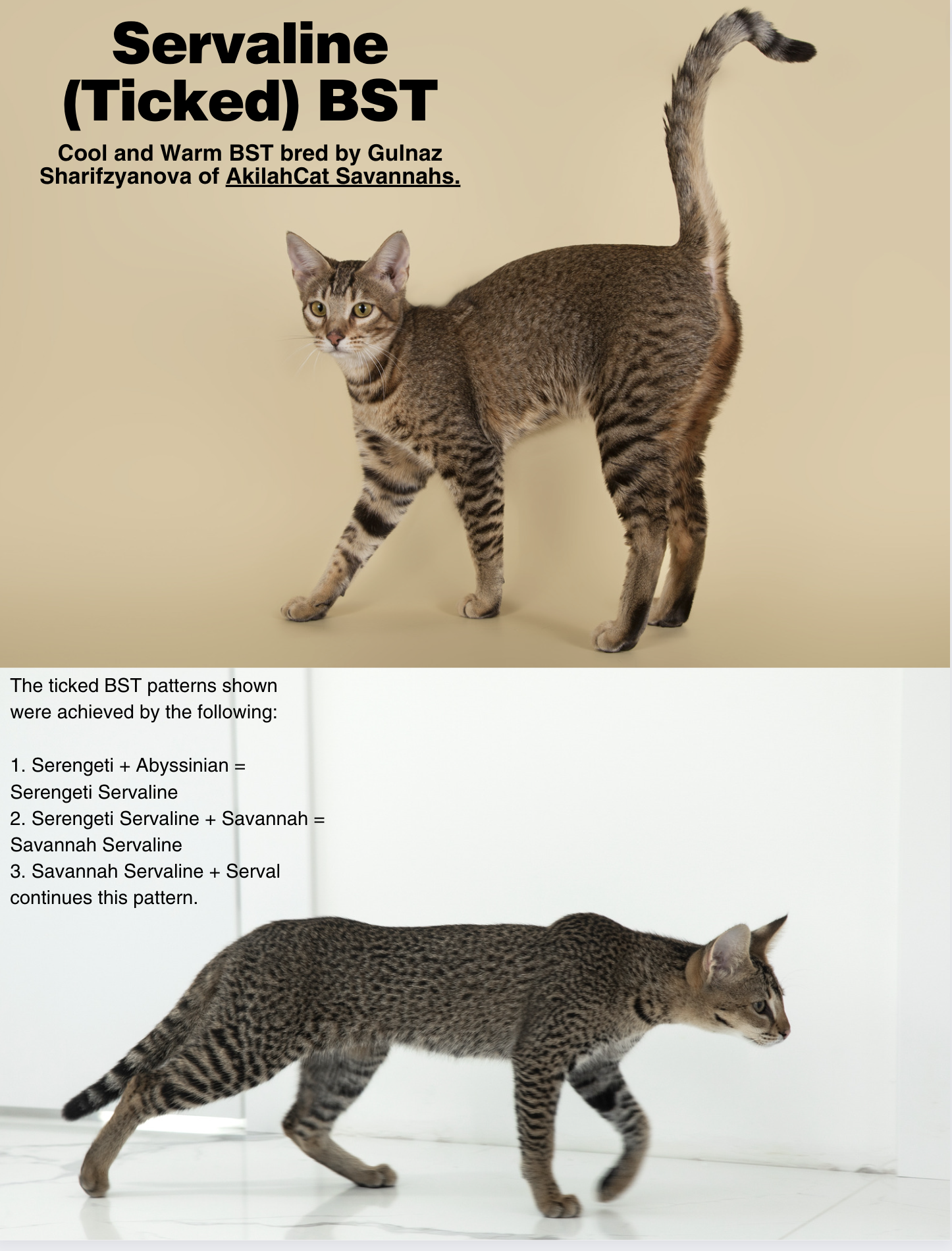What’s All the Fluff About Fur?
Edited by: Brigitte Moyne of Kirembo Savannahs
The Coats, Colors, and Patterns of Savannah Cats
Savannahs come in several different colors and variations of these colors. Per the Savannah breed standard, permissible colors can be golden/brown, silver, black, and smoke, and patterns that include solid and spotted tabby. There are, however, many other color variations. While not acceptable in a cat show ring, cats of different colors and patterns can still be registered with TICA and are highly desirable by many Savannah owners. How colors and markings are passed along from studs and queens to their kittens isn't easy to understand and difficult to predict, even for experienced breeders. In this article, we'll touch on Savannah colors and patterns, genetics, and the abbreviations you'll often see in posts, photos, and articles about Savannah cats.
Genetics is a complex study in its own right, and there is always something new to learn.
In the following sections, we'll examine how some of the best-known Savannah cat colors come about.
Black Savannahs can be solid or have black spots, most generally seen in the light.
Brown Spotted Tabby Savannahs can be cool to warm brown, tan, or gold with black or dark brown spots (BST = black/brown spotted tabby)
Silver Spotted Tabby Savannahs have a silver coat with black or dark grey spots.
Black Smoke Savannahs have a silver undercoat with black spots.
Savannah Cat Permissible Colors by TICA Guidelines
Silver Base Coat Black-Spotted Tabby (SST "silver-spotted tabby")
Silvers come in many different shades ranging from light to dark charcoal silver. Spot colors range from charcoal to inky black. Many silver Savannahs also have a black noses. The silver color was introduced into the breed when domestic cats of different breeds were used to create the Savannahs.
Genetically, The inhibitor gene eliminates the yellow pigment in the agouti hairs (background color) but doesn't affect the nonagouti areas (the markings). The inhibitor gene may suppress all or very little of the yellow pigment, which results in some cats having a more washed-out brown color. "Tarnish" is when an SST has brown tinges at the nose and other extremities. The genetics behind it are poorly understood.
Brown Spotted Tabby (BST)
The golden/brown Savannahs are what most people are familiar with as they most closely resemble their African Serval ancestors. The basecoat has various shades of brown referred to as "tone." These tones range from cool to warm. The base coat colors range from cool beige to golden yellow and every shade in between. The spotted tabby markings can vary from a red-toned brown to an inky black. Paw pads should be charcoal or dark brown. The nose leather can be a range of colors, including pink or brick red surrounded by a darker line, solid black, or black with a center stripe in brick or pink, like the Serval cat.
Cool-Colored Brown Spotted Tabby (BST)
The cool-coated Savannah has a light/cool beige to golden yellow basecoat and dark "inky" spots. The "charcoal gene" is also found in Savannahs, which results in a very cool-toned tabby with extremely bold black markings.
Warm-Colored Black Spotted Tabby (BST)
A Savannah with a warm-toned coat is more vibrant, and the spots can range in color from orange to brown to black.
Black Melanistic
Melanistic Savannahs are black but still have spots that are difficult to "spot" on the body and the rings on the tail--unless in good lighting. The melanistic color is acceptable by TICA standards and shown at TICA cat shows. Black Savannah cats look pure black at first glance and in pictures. With closer inspection, they have the classic Savannah spotted pattern across their bodies and rings of darker color on their tails, known as "ghost spotting." A black Savannah cat's paw pads should be dark brown or charcoal, and their nose leather solid black. It's important to note that the black nose of the melanistic isn't the same as in BST and SSTs. It's the result of the nonagouti (no pattern gene). The gene for black noses in BSTs and SSTs hasn't been identified but appears to be a recessive trait.
Black Smoke
Smoke-colored Savannahs are black but have silver hair roots, lightening their overall appearance and visible markings. A black smoke Savannah cat initially looks black, but when you part its coat, you can see that the roots of its hair are white. It's easier to see the spotted markings on a black smoke than on a black (Melanistic) Savannah. Their paw pads should be dark brown or charcoal, and their nose leather should be solid black.
Savannah Cat Breed Standard Non-Permissible Colors
Besides the four primary colors accepted by TICA's breed standard for the Savannah cat, you may see other colors of the Savannah cat, as mentioned above. These cats can't attend shows, but owners prefer them for their eye-catching appearance!
Snow Savannah, aka Seal Lynx Point (including SLP)
The rare Snow Savannah is highly sought after by pet owners. The blue or aqua-colored eyes of the snow Savannahs are pretty mesmerizing. Snow Savannahs can come in many color variations, such as seal, chocolate, lilac, blue, tortie, and red. They have a very pale base coat, ranging from ivory to beige. Their spots are pale brown but with enough contrast from the base coat to be visible. This coloring will sometimes be more visible on the cat's legs, tail, and head points. Solid colorpoints are also snow and do happen--so seal point, chocolate point, etc.
Lilac (dilute chocolate)
Lilac Savannahs have a cream base color with gray markings. The lilac/lavender color is scarce and is technically a dilution of brown. It's only possible when a specific combination of recessive genes is present.
Chocolate Spotted
A Chocolate Savannah resembles the brown spotted but has no black on the cat, only dark or light brown spots.
Chocolate Point (recessive)
Chocolate is a recessive color of dark brown with warm overtones. Any markings will be dark brown to a black shade. The chocolate point generally has ivory-white fur, which stays pale throughout its lifetime, differing from seal points, whose coats tend to darken as they age. Seal points sometimes end up with darker coats as they mature. Their nose leather and especially their paw pads have a pinkish undertone. (If in doubt, this pinkish undertone is a good way of telling chocolate from a seal point, which has a dark brown nose and paw pads, with no pink showing at all).
Cinnamon (recessive)
The cinnamon coat color is recessive and is a warm pale brown coloration overlaid with darker markings. Both parents must possess this coat color to pass it on to their kittens, making this coat color very rare.
Fawn (dilute of cinnamon)
Fawn is a warm beige with pink overtones. It's a diluted version of the cinnamon coat color and recessive, so both parents must carry it.
Blue or Gray (dilute black)
The blue coat color is the result of a dilute black coat. It can be seen in any of the three spotted, marbled, or rosette Savannah patterns.
Savannah Cat Coat Patterns
Like their Serval ancestor, most Savannah cats have spots (Tabby), the pattern many breeders aim to produce. The Tabby gene is highly diverse and involved in many coat patterns. There are wide varieties or types of spotting patterns, such as large, irregular, or small spots.
Spotted
TICA only accepts the spotted pattern for the Savannah breed standard. The cat's body must have round, elongated, or oval bold spots, which will be dark brown to black. A series of parallel lines will be on the back of the cat's head and extend over the shoulder blades, fanning across the back. The spots over the cat's back should follow this line. The Savannah cat's legs, feet, and face may have smaller spots. Lines breaking up into spots along the spine are a Serval trait found in Savannahs, while domestic tabbies tend to have a solid line along the spine. Spotted Savannah cats also have distinctive ear markings called "ocelli." Ocelli resemble a set of eyes and occur in other species in nature, such as the wings of butterflies and the ears of other wild cats. Their purpose is to confuse predators by resembling a set of eyes, making the predator think the other animal sees them.
Marble
Marble Savannahs have the same body shape, personality, and size as spotted Savannahs. The Marble pattern is recessive and comes from the domestic cat breeds that initially created the Savannah cat. Marbles are not accepted in the official breed standard because they don't resemble the pattern of the African Serval cat. The marbled pattern has large spots and stripes across the body and comes in shades of gray, silver, black, tan, and brown.
Rosette
The breed standard doesn't accept the rosette pattern. These Savannah cats have large oval "rosettes" surrounded by stripes and spots. This pattern is more similar to a Bengal cat pattern. Most assuredly, this is from using Bengal outcrosses with the Serval in earlier breeding days. Rosettes are two-toned spots with a lighter-colored center with a darker ring surrounding that center. While strikingly beautiful, many Savannah owners covet rosette patterns.
Torbie
The Torbie Savannah cat is rare. These cats share looks with a Tortoiseshell and a Tabby cat. Sometimes, we call them "patched tabbies" because they look mainly like Tabby cats with a few patchy areas of red and cream.
Torbie cats are the most difficult to differentiate. But once you identify the Tabby pattern (classic, spotted, mackerel, or ticked), look for little patches of a different color. If you find both, you likely have a Torbie cat. This photo is my F5 Savannah, Phoebe, who we believe is a Torbie!
The Orange (O) gene in cats gives you a tortoiseshell color—a patched orange and black pattern. This pattern is likely because the "O" gene is incompletely dominant over the "non-O" gene. This dominance allows the underlying color of black (or chocolate, cinnamon, blue, etc.) to show in some places. It's an "X-linked" gene, so if a female only gets one "O" gene, she is a tortie/torbie. If she gets two "O" genes, she's orange (or red in cat terminology, which is odd when the gene is orange). Males usually only have one "X," so they will be red (orange). A rare tortie/torbie male is XXY and generally sterile. (source: Brigitte Moyne)
Servaline or Brown-Ticked Tabby (BTT or STT)
This Ticked pattern is rare, and few breeders will breed for this pattern. This pattern can be Brown Ticked Tabby (BTT) or Silver Ticked Tabby (STT). The use of Abyssinians in the earlier breed influences the Servaline pattern. The Servaline cat has very fine or almost indistinct spots, giving a speckled appearance rather than the large spots from the Serval. The tiny spotted pattern occurs because the ticked tabby gene is incompletely dominant over the spotted tabby gene. So, when a cat has one copy of each, the ticked pattern breaks into tiny spots.
Non-Standard Traits of the Savannah Cat
White toes
White locket of hair
Long hair
Marble pattern
Servaline pattern
Ticked pattern
DNA/Genes, Chromosomes, and Alleles
The saying in the cat world is, "all cats are tabbies," this is where I dust off my biology books from nursing school! Despite numerous genetic variations, I've found that there are only two primary coat colors: Black and Red. The other coat colors are variations of either black or red. The only exception to this rule is White. When a cat has white fur, this means there is an inhibitor gene present that masks all underlying colors. The Savannah cat breed does not display a solid coat pattern at all. There is always an underlying pattern or "ghost spotting," even in those who appear solid at first glance. The spots and stripes are variants of the Tabby (Agouti) coat pattern, described further below.
Some genes that code the fur color and pattern are dominant, so the kitten only needs to receive that gene from one parent to express it. Other genes are recessive, and the kitten must receive that same gene from both parents to show it. Some genes can dilute the effect of other genes. Black is a dominant color gene. A cat with black fur genes and a "modifying gene" can become grey, smoke, silver, or blue. Likewise, diluted red fur becomes cinnamon or cream.
Cats each have 38 chromosomes (19 chromosome pairs). Chromosomes come in pairs which they inherit from both parents. Cats get 19 chromosomes from each parent. Inside each chromosome are genes or DNA, which control the different aspects of the kitten's appearance. The makeup of a cat's fur may contain as many as 20 genetic instructions that control the fur's color, pattern, length, and thickness. Some genes are present; some are not present. The gene for white fur is an example. Some genes can have two slightly different versions called "alleles." Alleles, depending on their combinations, give different outcomes. Alleles are why Savannah cats come in so many variations due to other breeds of domestic cats used in the earlier days of their creation.
How Can I Learn the True Color of My Savannah Cat?
https://vgl.ucdavis.edu/panel/cat-coat-color
This basic cat coat color panel bundles several genetic tests for coat color applicable to all breeds.
The panel requires a simple cotton swab. The cost is $55 per cat and offers a 15-day turnaround time. See below for the list of specific tests included in the panel.
Tests in This Panel
Agouti
The agouti signaling protein (ASIP) gene, or Agouti, interacts with the melanocortin 1 receptor (MC1R), regulating the switch from "eumelanin" (present as black, brown, cinnamon--or their respective dilutions) to "phaeomelanin" (present as red or yellow--or their respective dilutions). This pigment deposition switch occurs at specific points in the hair shaft of the growth cycle. This cycle results in individual banded hairs with the visual effect of an intermediate color between the two pigments. The length of the respective bands modulates the visual effect as well.
In domestic cats, a 2 bp deletion (c.123delCA) in the agouti signaling protein disrupts protein function. This mutation has an autosomal recessive mode of inheritance. Thus, when two copies are present, pigment switching is prevented, resulting in the hair of uniform color (often called solid or "self-colored"). A separate gene causes patterns of dark stripes or blotches (tabby patterns) interspersed with lighter hairs. Hairs in the darker stripes do not undergo the shift between black and red-yellow pigment production during their growth and thus remain uniformly dark. The areas outside of the dark tabby stripes are composed of agouti-banded hairs. The tabby pattern is still present in a nonagouti cat (a/a). Still, it is not visible since all the hairs in the pattern and outside the pattern are uniform.
Occasionally, you'll see a tabby pattern, despite a homozygous recessive (a/a) genotype at the agouti locus. A sex-linked red/orange cat will exhibit the tabby pattern regardless of whether it is Agouti (A/A or A/a) or nonagouti (a/a). We can occasionally observe a faint tabby pattern on the body of a/a cats under certain lighting conditions, especially in kittens with the dilution variant. Lastly, Melanistic (a/a) Savannah cats often exhibit faint tabby patterns.
Brown (Chocolate and Cinnamon)
Cats with brown gene variants have reduced amounts of black pigment and appear brownish.
Colorpoint Restriction
Cats with colored 'points' have genetic mutations associated with temperature-sensitive pigment production. Pigment production is reduced in warmer areas of the body, leading to darker pigmentation in the cat's cooler extremities (paws, ears, etc.)
Dilute
The "dilute" coat is an autosomal recessive trait. It can occur in all coat colors as it causes clumping and uneven distribution of pigment granules in the hair shaft.


